Choosing a new set of bike tires is often taken lightly or done impulsively. This is either because we get overwhelmed by the range of different brands and models that the stores are flooded with or because we do not appreciate the importance of this bike component.
However, it is highly important not to take bike tires for granted for several reasons. This is the only point on our bikes that makes contact with the ground, so it has crucial importance in determining how our bike performs and how it handles on the road.
But there are so many different types of bike tires on the market today. So, how to determine if you need slick, tread, studded, or whether to go with tubular or not? Which valve type to choose? And what about the brand? The first step is to realize the importance of and learn more about this crucial part of our bikes.
So, that’s exactly what we’re about to do. Let’s see, how to choose bike tires.
Contents
Bike Tire Sizes
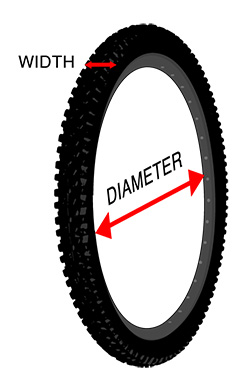 Bike tires come in a bewildering array of sizes. All of them differ in two dimensions: tire diameter and tire width. The tire diameter is determined by measuring the distance between the two outer ends of the tire, while the tire width is determined by measuring the distance between tire treads or the outside walls of the tire. For road cycling, we use the metric system while for MTB we use the imperial system to express the measures.
Bike tires come in a bewildering array of sizes. All of them differ in two dimensions: tire diameter and tire width. The tire diameter is determined by measuring the distance between the two outer ends of the tire, while the tire width is determined by measuring the distance between tire treads or the outside walls of the tire. For road cycling, we use the metric system while for MTB we use the imperial system to express the measures.
Therefore, when choosing a bike tire size, you should have several things in mind. A large diameter tire will give you more speed, but it will take away some stability. With tire width, it’s the opposite. Slim tires will roll faster and cause less resistance, but they will perform poorly on loose surfaces. On the other hand, fatter tires roll more slowly, but they will help you stay on track more easily.
So, in order to choose the correct bike tire size, you should make figure out what is more important for you, speed or stability, and make a compromise.
To learn more about tire sizes, read our in-depth article bout them.
Related: Mountain Bike Guides, Articles & Reviews >
Bike Tire Width
This is the tire dimension that you will need to think about more since your diameter will already be determined by the size of your wheel (unless you want to change your wheels entirely). Basically, you need to determine what is important for you and what kind of riding style you prefer.
If your rides are most often on hard and smooth surfaces, you can use narrower tires because you will want to go faster and do not need so much traction. If the terrain where you ride is bumpy, rocky, or very loose because of gravel, you should go for wider tires to increase contact area and grip. Another advantage of wider tires is that in case the terrain is very loose or covered in sand, you can deflate them and, in that way, gain even more traction.
Mountain Bike Tires
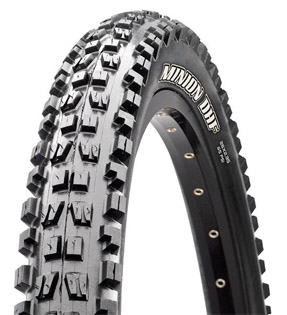 Mountain bike tires are specifically designed for off-road riding and usually have an emphasized knobby tread which improves grip. The most popular diameters are 26” and 27.5”, but 29” is common as well. Tire width comes in different sizes and varies depending on the type of bicycle and the type of riding.
Mountain bike tires are specifically designed for off-road riding and usually have an emphasized knobby tread which improves grip. The most popular diameters are 26” and 27.5”, but 29” is common as well. Tire width comes in different sizes and varies depending on the type of bicycle and the type of riding.
- Cross country bikes have tires in the 1.8”-2.2” range
- Trail and all-mountain bikes are usually fitted with 2.25”-2.4” tires
- Downhill bikes require more grip and need to withstand more impact so they usually have 2.5” wide tires
- Fat bikes use much wider tires, from 3.7” all the way to 5” width.
Related: Best Mountain Bikes Under $500 >
Apart from being wider, mountain bike tires differ from other types of tires in several other aspects. For example, some MTB tires are front/rear specific. That means that the tread on them is designed in such a way that it provides the best traction when used on the intended wheel. They are usually sold in pairs. Moreover, they are made of more durable compounds due to the abuse they need to withstand and some Trail and Down Hill tires are even armored or double-plied to prevent punctures.
See the MTB Tire Selection on REI
Road Bike Tires
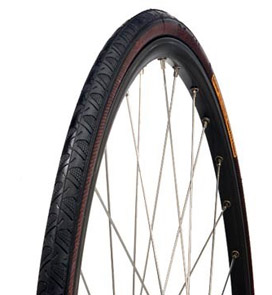 Road bike tires offer a bit less variety when it comes to size, compared to MTB tires. The standard tire diameter is 700c, while 650b tires can be seen as well, usually to provide a smaller stand-over clearance for riders. These are equivalent to 27.5” tires for mountain bikes.
Road bike tires offer a bit less variety when it comes to size, compared to MTB tires. The standard tire diameter is 700c, while 650b tires can be seen as well, usually to provide a smaller stand-over clearance for riders. These are equivalent to 27.5” tires for mountain bikes.
Most racing bikes ride on tires that are in the 18mm-23mm width range. During training, or in conditions where additional grip is required 25mm and 28mm are also used. The narrower the tire, the lower the traction will be, and the faster the bike. However, stability and comfort will suffer as well.
Most road bike tires are slick, meaning that they have no tread, or they have indentations to provide better cornering grip, but not sacrifice rolling speed. However, because they are slimmer and thinner, they are more prone to punctures and wear and tear.
See the Road Bike Tires on REI
Bike Tire Features
Apart from differences in sizes, bike tires also have other aspects and features that make them more suitable for different situations.
Bike Tire Rubber Softness
Tires can be made using only one type of rubber, or more types at the same time. Most tires are made of either soft or hard rubber, depending on what kind of performance you want. Soft rubber tires have better grip but don’t last very long and some need to be changed after several rides. Hard rubber tires are more durable but less adaptable to the surface. Some riders decide to choose dual-compound rubber tires, so they can get the best out of both types, but these tires are usually more expensive.
Puncture-Resistant Tires
This can be done in two ways, either by adding thicker and more durable treading or by inserting a belt of aramid fibers that protect the inner tube. Either way, these tires last longer and rides experience fewer flats.
Threads Per Inch (TPI)
Every bike tire is made of a carcass of durable fiber the holds the tire together. This carcass is rated in term of TPI, or threads per inch, and is important for road cycling.
A high TPI (120-320) means that the tire will be light and fast, but it will be less durable. A low TPI tire (60 and below) will be heavier and sturdier, but it will have fewer punctures and it will last longer.
Studded Tires
Some tires, intended for winter use, have steel or aluminum studs on their treads to provide even better traction in slippery conditions.
Foldable Tires
These tires can be folded and easily brought along because of an aramid-fiber bead, instead of a wire bead (the part of the tire that falls into the rim). They are popular among bicycle travelers because they are light and practical, but they are on the expensive side.
Tubeless Tires
These tires, as the name implies, do not have tubes. This has several benefits, like being able to ride on lower pressure while avoiding pinch flats. However, in order to install them, you will need to invest in tubeless-ready rims or buy a conversion kit for your standard tires and rims. This conversion process can sometimes last a couple of days.
Related: Tubeless Tires 101
Related: Road Bike Guides, Articles & Reviews >
Tire Tread Patterns
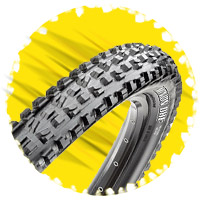 Tire tread patterns differ substantially for road bike tires and MTB tires. They are much more important for MTB because of the type of terrain these bicycles are usually ridden on. In case of road bike tires, the main concern is water in wet conditions.
Tire tread patterns differ substantially for road bike tires and MTB tires. They are much more important for MTB because of the type of terrain these bicycles are usually ridden on. In case of road bike tires, the main concern is water in wet conditions.
Road Tire Tread Patterns
In case of dry weather and smooth surfaces, tread pattern on a road tire is not that important and these tires are usually without treads, better known as slick tires. They roll very fast on the road and lower resistance, while their traction when cornering is determined by softness.
In case of wet weather, road tires usually have some grooving in them in order to increase traction, but also to direct water to the side of the wheel. These grooves are usually V-shaped and run the whole length of the tire.
Mountain Bike Tread Patterns
When it comes to MTB’s, tread patterns are very important and there is a much bigger variety. The type of tread you choose is determined by your preferred style of riding.
If you ride a mix of road and hard-packed trails you can get by with a semi-slick tread that has knobs only on the sides to improve cornering.
If you want to ride on more robust surfaces, you will need taller knobs that will bite better into the ground and prevent skidding.
In case you plan to ride in wet conditions, you will need a tire where knobs are widely spaced so that the mud can shed off more easily off them.
Finally, also consider the softness or hardness of your tire rubber. A softer tire will provide more grip on slippery rocks but will wear off more easily. However, a harder tire will be more durable, but it performs worse in slippery conditions.
Mixed Tread on Front and Back
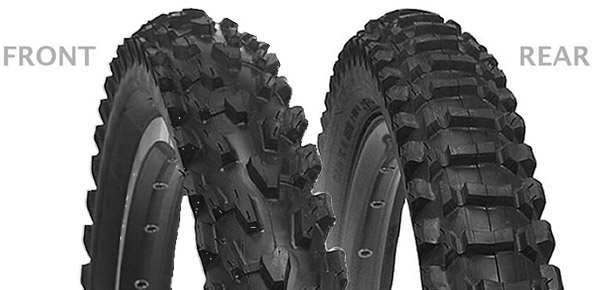
Many mountain bike riders put tires with different threads on their front and back wheels in some situations.
For instance, when riding on a hard-packed single track, you can put a knobby tire on the front wheel to improve grip when cornering and a smoother tire on the back in order to improve speed. The thing to have in mind though is that the two tires should still have the same outer diameter and width or you can easily lose stability.
Bike Tire Valves
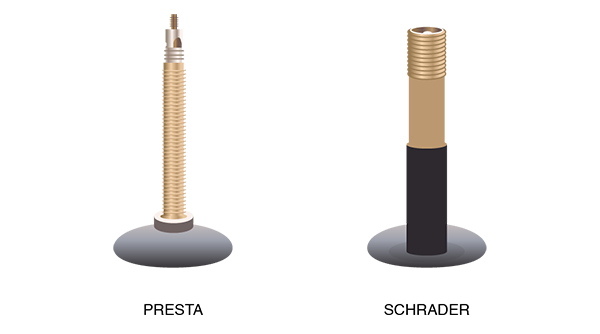 There are two types of tire valves in standard use: Presta and Schrader valves.
There are two types of tire valves in standard use: Presta and Schrader valves.
Presta Valve
Presta valves, also known as French valves, are most common on the high-performance road and mountain bikes that require high air pressure. They feature a valve cap that needs to be opened before the air is pumped. They are featured on high-performance bikes because they are slim, so the hole in the wheel that decreases its stability can be smaller.
Schrader Valve
This valve type is more common and is also referred to as a car valve. These valves are more practical as they are compatible with automated air pumps at any gas stations. However, they are large and sturdy and slowly leak air over time, which is a downside.
What Is the Right PSI?
 There isn’t one simple answer to this question. The right PSI (Pound per Square Inch of air pressure) is determined according to several factors. The type and size of tire, the terrain and weather, and the weight of the rider. Generally speaking, lower PSI increases grip due to wider contact patch, which is the part of the tire that makes contact with the ground.
There isn’t one simple answer to this question. The right PSI (Pound per Square Inch of air pressure) is determined according to several factors. The type and size of tire, the terrain and weather, and the weight of the rider. Generally speaking, lower PSI increases grip due to wider contact patch, which is the part of the tire that makes contact with the ground.
You want to find the golden middle and not go too soft (which can cause pinch punctures or damage your rims) or too hard (which can cause a bumpy ride and decrease grip). Here is a comprehensive table that should serve as a guideline for you, taking into account the weight of the rider and bike tire.
Learn more: Tire Pressure Explained
Road Bike Tires
| Rider Weight | Air Pressure |
| <60 kg / 130 lb | 6 bars / 87 psi |
| 60-70 kg / 140-175 lb | 7.5 bars / 94-108 psi |
| >80 kg / 175 lb | 8-8.5 bars / 116-123 psi |
Read our complete road bike tire pressure guide to learn more.
Mountain Bike Tires
| Rider Weight | Air Pressure |
| <60 kg / 130 lb | 2-2.2 bars / 29-32 psi |
| 60-70 kg / 140-175 lb | 2.4-2.6 bars / 35-38 psi |
| >80 kg / 175 lb | 2.8-3 bars / 41-43 psi |
Tubed vs Tubeless
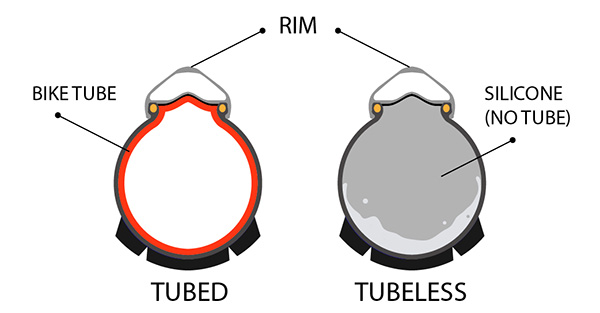
The argument of running tubed or tubeless tires is most probably the Pandora’s box of cycling. You will always have those who claim that the hassle of going tubeless is not worth it. However, others will argue that running tubes just have too many benefits.
Both types of bike tires have their advantages and disadvantages. We’ll present you with these since there isn’t one simple answer.
Why You Should Choose Tubed Bike Tires?
 Ease of use. Regular tires are very easy to mount and take off. You can do it with very few tools or even just by using your hands. UST (Universal Standard Tubeless) tires, on the other hand, need more tools, knowledge, and time to mount them or take them down.
Ease of use. Regular tires are very easy to mount and take off. You can do it with very few tools or even just by using your hands. UST (Universal Standard Tubeless) tires, on the other hand, need more tools, knowledge, and time to mount them or take them down.- Because standard tires have tubes, it means that the tire itself can be thinner and more adaptable. This way, it will handle better in corners and over bumps, but at the same time, you risk getting pinch flats because you will have to deflate it to get this effect.
- Tubed tires are usually slightly lighter than their tubeless counterparts. This does seem counterintuitive, but it might be because of the weight of a tubeless rim, or the amount of sealant that is applied.
Why You Should Choose Tubeless Bike Tires?
- Air pressure. Even though tubed tires have better compliance features, tubeless tires can run on lower pressure. Since the risk of pinch flats does not exist, you can lower your pressure and get a better
- Rolling resistance. Even though tubeless systems are heavier, they have fewer moving parts since there are no tubes, so they have a lower rolling resistance. You will feel this benefit, especially at a lower air pressure
- Puncture resistance. Riders who ride on tubeless tires get a lot fewer flats than their counterparts. This has to do with the robustness of tubeless tires, but also with the sealant that is applied in the installation process.
As you see, there are benefits for both tire types. So, if you tend to change your tires often, you should stick to tubed since they are easier to manage. Otherwise, you should go with tubeless and get a better cycling performance.
Read our guide on tubeless tires to learn more.
How to Change a Tire?
Whether you have a flat, or you just want to swap your tires, you will need to know how to do that. If you’re using tubeless tires, all you will need are a set of tire levers and a spare tube. With tubed, you can also try to repair the tube but it’s always better to use new tube.
If you have V-brakes, you first need to unclip them and take your wheel off the bike. After that, deflate the tube (if it isn’t already), push one tire lever between the tire and the rim and lift it. Push the other tire lever in and lift the tire out of the rim in one circular motion. After that, take the tube out, take your tire off and do everything in reverse order to put it back on.
If you want to see the whole process in action, take a look at this YouTube video.
What Do the Numbers Mean on a Bike Tire?
 The numbers on the side of a tire are a cause of a lot of confusion. Today, bike tires are marked according to an ISO standard. This is a combination of two numbers separated by a dash, where the first number is the tire width and the second number is the bead diameter (e. g. 37-622).
The numbers on the side of a tire are a cause of a lot of confusion. Today, bike tires are marked according to an ISO standard. This is a combination of two numbers separated by a dash, where the first number is the tire width and the second number is the bead diameter (e. g. 37-622).
However, the old English and French markings are still used, in addition to the ISO mark, you will also see something like 26×1.5 or 700x35C. In this case, the first number shows the outer diameter of the tire, and not bead diameter, like in the ISO case, and the second one represents tire width. The letter ‘C’ on French markings (e. g. 700x35C) represents the inner (bead) diameter and it stands for 622 mm.
To read more about the topic, read our in-depth guide about bike wheel sizes.
What Are Some Good Bicycle Tire Brands (And Where To Shop)?
Bike tires differ from one brand to another in terms of quality, durability, and performance. Every brand uses different rubber compounds to make its tires. Plus, different types of bike tires are made to fit different needs. Therefore, every tire is different in terms of softness, grip, and rideability. Or as many cyclists say, “Every tire has its own character.”
There are way too many brands on the market, and the general rule is that you will have to pay more in order to get a good quality tire. We’ve created a list of ten most popular road and mountain bike tire brands that have been tested and proved in terms of both quality and performance.
Top 10 Bicycle Tire Manufacturers
- Bontrager
- Continental
- Maxxis
- Michelin
- WTB
- Clement
- Schwalbe
- Specialized S-Works
- Zipp
- Vittoria
- and some more…
Where To Shop?
- Trek.com – Bontrager tires (Our favorite tires)
- Amazon
- REI.com
- JensonUSA.com
FAQ
Here’s a list of the most common bike tire questions riders will have. In case you need some quick answers to your questions, check out the FAQ section to satiate your curiosity fast.
What tire do I need?
In order to answer this question, you need to know what kind of a bike you are riding, what style of riding you prefer, and what the size of your wheels is. After that, you will know what tire to buy for your bike.
Where should I buy bike tires?
Your best choice is to buy them at a local bike shop or online if you find better deals there.
Do bike tires come in pairs?
Bike tires do not come in pairs generally, but it’s a good idea to read the product description and know what you’re going to get.
What width tire should I choose?
The tire width is determined by what style of riding you prefer. If you ride on loosely packed surfaces, you will need wider tires to gain better grip. On the other hand, if you ride on hard-packed surfaces or on roads, you should buy narrower tires in order to lower resistance and improve speed.
Should I go tubed or tubeless?
It depends. Both choices have advantages and disadvantages. Tubed tires are easier to manage and lighter but get more punctures. Tubeless tires are harder to put on and take off and are heavier but they perform better overall and have fewer punctures.
How often do you need new bike tires?
The general rule of thumb is that when the tire is not visibly broken or not deteriorating, it’s fine to use. However, how much they are used and the quality are some of the biggest impact factors. Higher-quality tires should last at least 2,000-2,500 miles, but this number can stretch up to 3,500 or 4,000+ miles.
Are 700C wheels the same as 29”?
Yes, they are the same. The inner diameter (bead) is the same, while the outer diameter is different. However, a very wide 29” tire might not fit on a standard 700C rim. At the same time, a very narrow 700C tire might not fit well on a wide 29” rim.
What is a folding bike tire?
This is a type of tire that features aramid-fiber base instead of a wire base, so it is more flexible and can be folded and transported more easily.
How much PSI should my bike tires have?
This depends on the type of tires you have, the surface you ride on, as well as your weight. A very high PSI will decrease the contact patch so traction will be lower. However, a low PSI will improve traction, but it might cause pinch punctures in tubed tires. Therefore, there should be a compromise between the two.
Can you mix and match bike tires?
Mixing different tire patterns might not be the best idea. Bicycle tires should be from the same manufacturer, with the same tire pattern, and in the correct size.
Some mountain bikes do come with different-sized wheels sometimes, so in this case, it is acceptable to have tires in two separate sizes.
Have a Question? Ask below

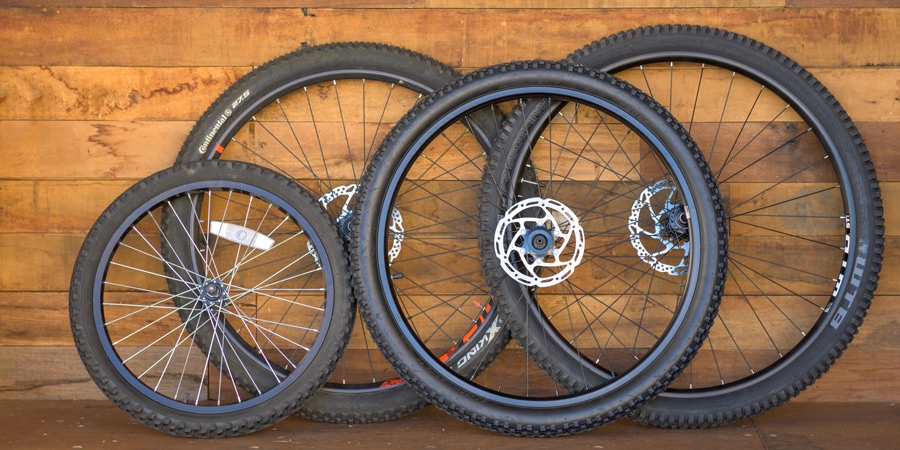
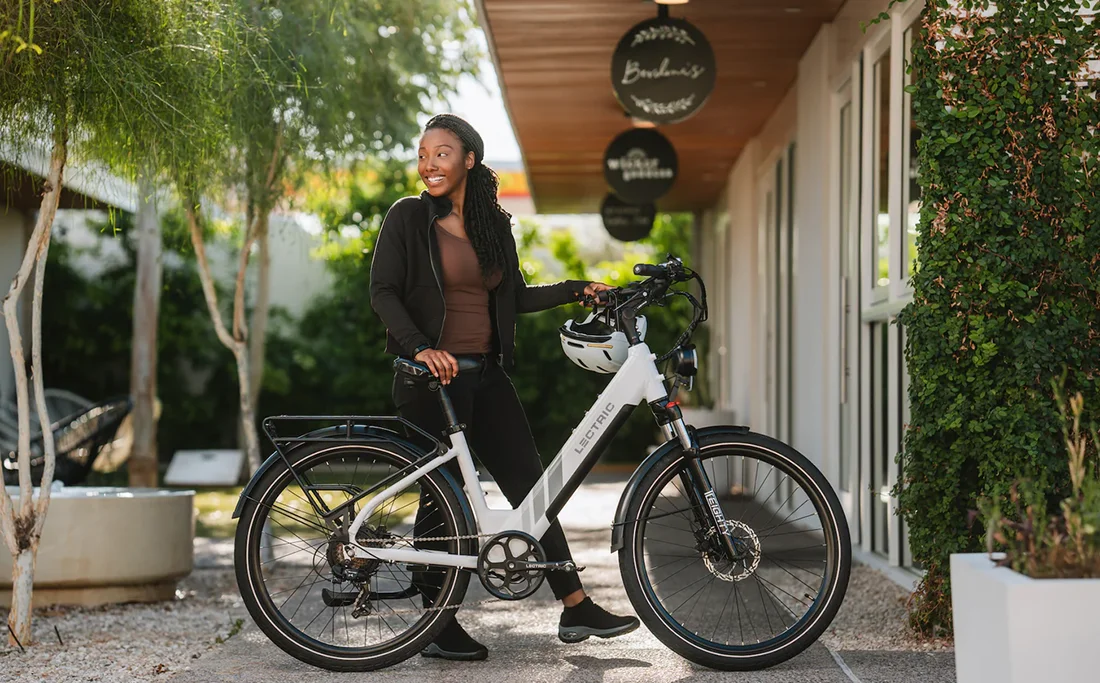
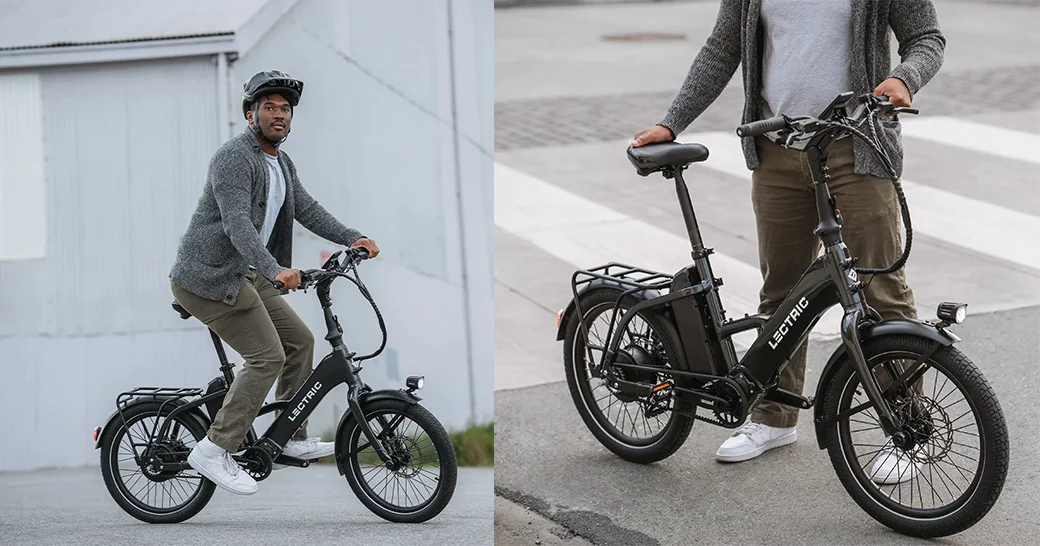
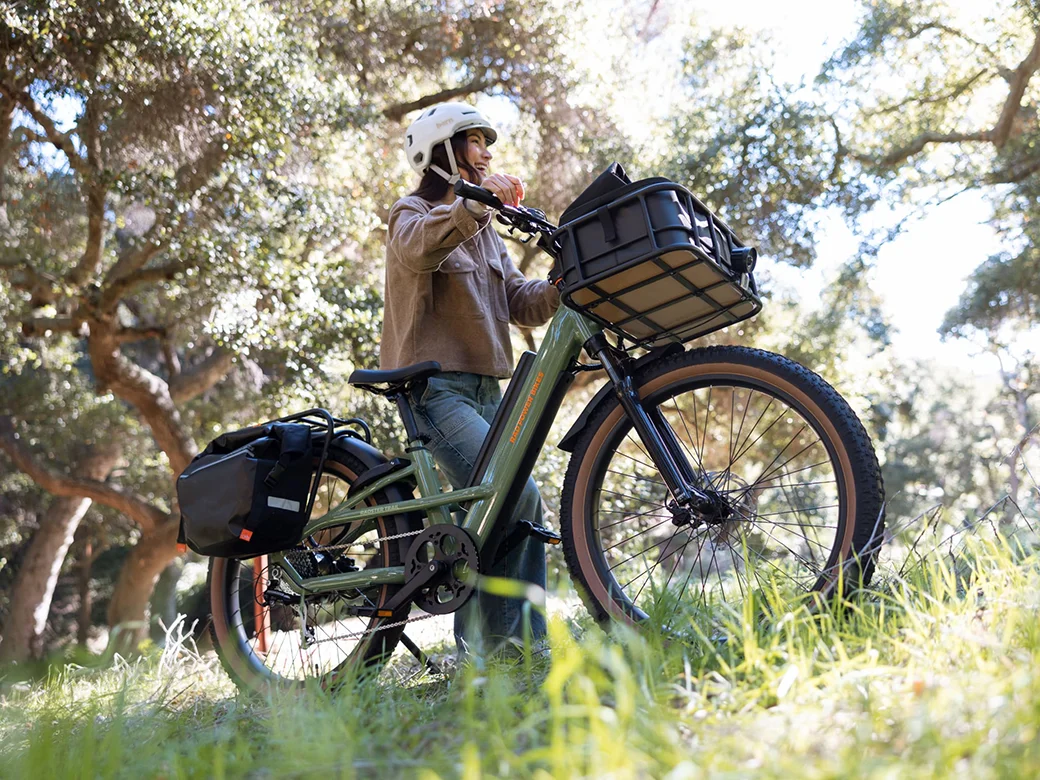
My wife rides a 1985 vintage Japanese steel road bike with 700-25 Michelin Tracker tubed clincher tires and skinny Araya aluminum rims. She used to be comfortable on this bike, but now is asking for something a bit more forgiving. The frame has a little bit of space for wider tires, perhaps 3/16″ on either side, near the bottom bracket. Will it make a big difference for her in stability if I replace the tires with 700-28 or 700-32 tires, or is time for a different bike? Thank you.
Hi Bob, thank you for your comment!
Fitting wider tires will definitely make a difference in comfort and stability. If there is enough clearance for 700-30 or 700-32 tires, I recommend giving it a try. Just make sure not to pump them all the way up to or they’ll feel uncomfortable as well.
If your wife is still not content, I recommend getting a gravel bike with a more upright geometry and 35+ mm tires. That is definitely going to be a lot more comfortable.
In the bike tire section, there might be a typo since it says slim tires roll faster. Then the next sentence says fatter tires roll faster. I was confuaed. Thanks for the great information though!
Thank you for letting us know, Jennifer! We’ve just corrected the mistake!
This is most completed and helpful information i ever read. Thanks so much for shearing your knowledge.
Thanks! I’m happy I could help!
I’m trying to buy my first mountain bike and can’t figure out one thing I. 5.7 and should I get small frame with 29 tires or medium frame 27.5? Because would that change the fit?
Hi Tony,
The tire size changes the fit, especially the standover clearance. You should measure your inseam length and compare it to the standover clearance of the bike you want to buy. The rest of the geometry will not change too much, so you don’t have to worry too much. For your height, a 16″/17″ frame would do the job.
Thanks for the post .. I never really knew the details about the bike tires.. I liked the video on changing the tires its very helpful.
Hi Madhusree Basu,
I’m glad you liked it and found it helpful! Make sure to check out the other pieces in our Cycling Advice section. 🙂
Love the winter tires content on your site!
Very nice article about how to choose bike tires. All the idea and guidance is very informational. Thanks